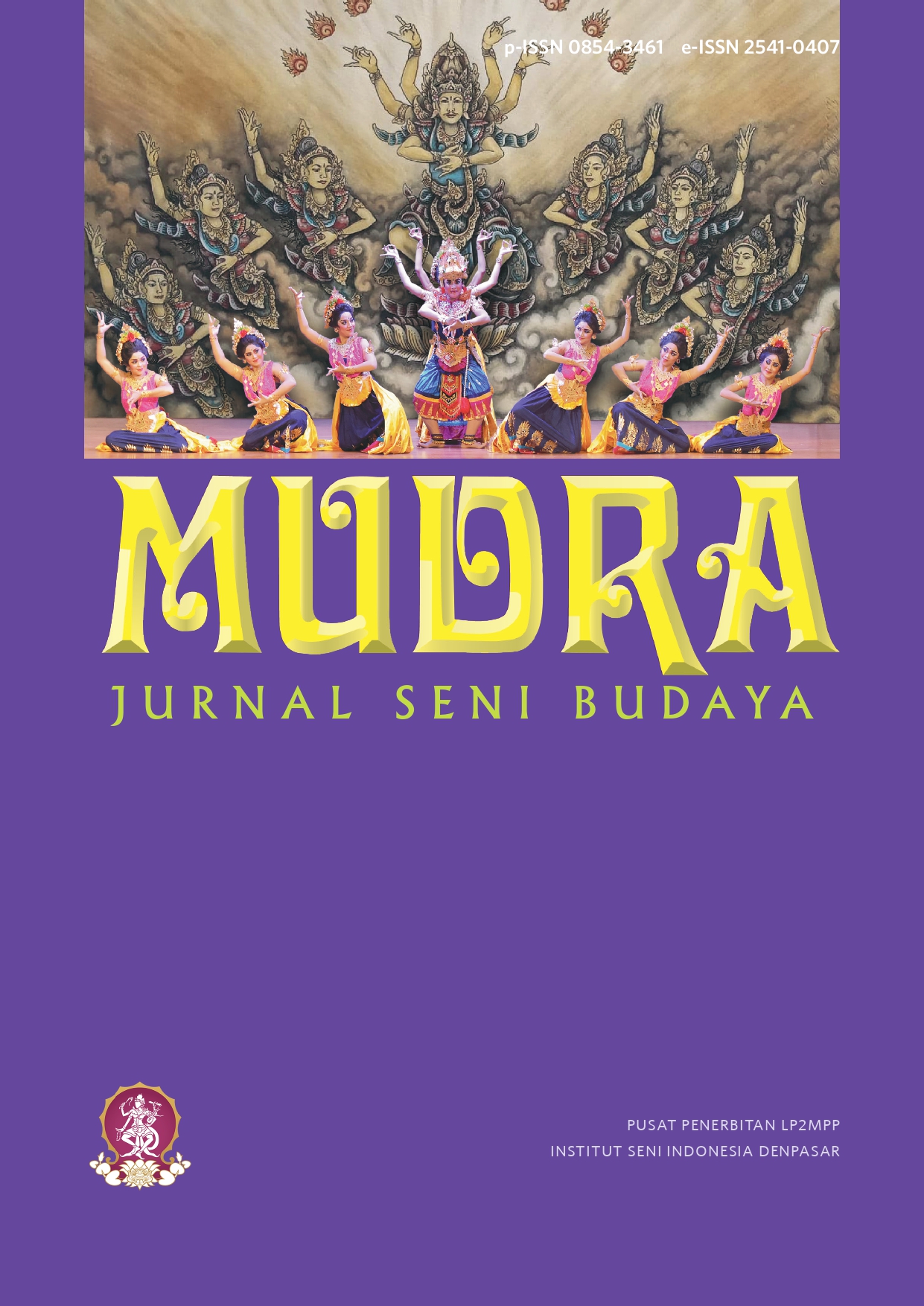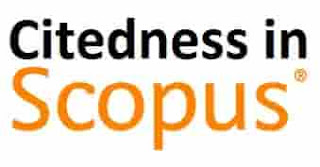Cultural Harmonization: Religious and Inter-Cultural Relations in Calengsai Arts
DOI:
https://doi.org/10.31091/mudra.v40i4.3114Keywords:
Calengsai Performance Art, Intercultural Dialog, Symbolic Rituals, Inter-Cultural Relationship, Cultural HarmonizationAbstract
The existence of Indonesian cultures and arts are rich in thought that is extraordinary to be explored, one of them is the typical Banyumas performance art, namely Calengsai (Calung, Lengger, and Barongsai), which is a local wisdom with a myriad of exploration sides for the people. This research tries to re-explore a Calengsai from the perspective of religious and intercultural relations, which mostly previous researchers only focus on the cultural and tourism aspects. This re-exploration of religious and intercultural studies is focus on model of cultural harmonization which purposed to break the conflict in the inter-cultural aspect that exist in Calengsai. The descriptive qualitative analysis is applied on this research to help the researchers to explore the evidence of the data which taken from the field collection. The study finds that Calengsai acts as a ‘third space’ of cultural hybridity where Javanese and Chinese traditions met through shared spiritual rituals, offering a scientific contribution to postcolonial and symbolic-interactionist scholarship by revealing how art creates new intercultural meanings.
Downloads
References
F. Faisal, M. Mahmudah, and R. Aprilia, “Dampak Kolonialisme Pembentukan Identitas Budaya Indonesia Dalam Novel Njai Kedasih: Poskolonial Homi Bhabha,” Titik Dua: Jurnal Pembelajaran Bahasa dan Sastra Indonesia, vol. 2, no. 2, pp. 113–125, 2023, doi: 10.59562/titikdua.v2i2.24068.
J. Schlehe, “Cultural politics of representation in contemporary Indonesia,” Eur J East Asian Stud, vol. 10, no. 2, pp. 149–167, 2011, doi: 10.1163/156805811X616093.
M. Budhianta, “Malang mignon Cultural expressions of the Chinese, 1940-1960,” in Heirs to World Culture, 1965, pp. 256–281.
E. Aldridge, “Phase-based account of extraction in Indonesian,” Lingua, vol. 118, no. 10, pp. 1440–1469, 2008, doi: 10.1016/j.lingua.2007.08.006.
P. Holmes and G. O’Neill, “Developing and evaluating intercultural competence: Ethnographies of intercultural encounters,” International Journal of Intercultural Relations, vol. 36, no. 5, pp. 707–718, 2012, doi: 10.1016/j.ijintrel.2012.04.010.
M. E. N. Islami and M. Ikhsanudin, “Simbol dan Makna Ritual Yaqowiyu di Jatinom Klaten,” Media Wisata, vol. 12, no. 2, 2021, doi: 10.36276/mws.v12i2.211.
A. Haris and A. Amalia, “MAKNA DAN SIMBOL DALAM PROSES INTERAKSI SOSIAL (Sebuah Tinjauan Komunikasi),” Jurnal Dakwah Risalah, vol. 29, no. 1, p. 16, 2018, doi: 10.24014/jdr.v29i1.5777.
N. Alifah, “Keberadaan Kesenian Calengsai di Kabupaten Banyumas Provinsi Jawa Tengah,” J Chem Inf Model, vol. 53, no. 9, pp. 1689–1699, 2018.
D. Tjaturrini and F. A. Mega FDL, “CALENGSAI SEBAGAI ASET BUDAYA BANYUMAS PENUNJANG PARIWISATA,” Melancong: Jurnal Perjalanan WIsata, Destinasi, dan Hospitalitas, vol. 6, no. 1, pp. 1–14, 2022.
D. Tjaturrini, T. Asiati, H. Prasetyowati, Z. Isro, and C. Arieshanty, “Calengsai and the intimate communications among faith believers,” IJoReSH: Indonesian Journal of Religion, Spirituality, and Humanity, vol. 1, no. 2, pp. 215–240, 2022, doi: 10.18326/ijoresh.v1i2.215-240.
P. Masyanda, I. Suryani, and D. Rahariyoso,"Hibriditas Tokoh Utama Ipuy dalam Film Lovely Man Sutradara Teddy Soeriaatmadja Kajian: Poskolonial Homi K. Bhabha," Pendidikan Bahasa dan Sastra Indonesia, vol. 15, no. 3, pp. 412-413, 2025.
E. Efendi, F. Fadila, K. Tariq, T. Pratama, and W. Azmi, "Interaksionisme Simbolik dan Prakmatis," Da'watuna: Journal of Communication and Islamic Broadcasting, vol. 4, no. 3, pp. 1088-1095, 2024, doi: 10.47467/dawatuna.v4i3.514.
H. Blumer, "Symbolic Interactionism: Perspective and Method," 1969. [Online]. Available: https://drive.google.com/file/d/1pa24WNO1gcr3SLe9ufLcm8mki7ecZd-P/view
F. A. Ranubaya and Y. Endi, "Analisis Privasi Dan Publikasi Postingan Media Sosial Di Kalangan Orang Muda Menurut Interaksionisme Simbolik Herbert Blumer," Metta : Jurnal Ilmu Multidisiplin, vol. 3, no. 2, pp. 133-144, 2023, doi: 10.37329/metta.v3i2.2455.
S. Marwah and T. R. Widyastuti, "Representasi Sejarah Dan Tradisi Kuno Banyumas: Antara Peran Perempuan Dan Pelestarian Adat Oleh Negara," Paramita: Historical Studies Journal, vol. 25, no. 1, pp. 109-117, 2015, doi: 10.15294/paramita.v25i1.3424.
G. Born, "The social and the aesthetic: For a post-bourdieuian theory of cultural production," Cult Sociol, vol. 4, no. 2, pp. 171-208, 2010, doi: 10.1177/1749975510368471.
A. Z. Ilyas and Z. Abidin, "Makna Spiritualitas Pada Penari Sintren Di Pekalongan," Jurnal EMPATI, vol. 5, no. 4, pp. 807-811, 2017, doi: 10.14710/empati.2016.15437.
N. S. S. Siregar, "Kajian Tentang Interaksionisme Simbolik," Perspektif, vol. 1, no. 2, pp. 100-110, 2016, doi: 10.31289/perspektif.v1i2.86.
M. Satoshi, “Hybridity and History : A Critical Ref lection on Homi K . Bhabha ' s ' Post- Historical ' Thought," vol. 41, no. 03, pp. 1-19, 2009.
M. J. Carter and C. Fuller, "Symbols, meaning, and action: The past, present, and future of symbolic interactionism," Current Sociology, vol. 64, no. 6, pp. 931-961, 2016, doi: 10.1177/0011392116638396.
S. Suharto, “Banyumas People’s Characteristics Symbolically Reflected on Calung Banyumasan Performance,” Harmonia: Journal of Arts Research and Education, vol. 18, no. 1, pp. 85–99, 2018, doi: 10.15294/harmonia.v18i1.11570.
H. Siswantari, L. D. Putra, and G. R. Hayu Kerti, “Spirituality of lengger dance in papringan hamlet Banyumasan,” International Journal of Visual and Performing Arts, vol. 4, no. 2, pp. 161–173, 2022, doi: 10.31763/viperarts.v4i2.646.
G. A. Noviansah, S. B. Istiyanto, and W. Novianti, “Negosiasi Islam dalam Budaya Ritual Lengger Banyumas,” Pendidikan Tambusai, vol. 7, no. 1, pp. 1455–1464, 2023.
A. U. Islam and A. Hidayat, “Makna Filosofis Barongsai dalam Agama Konghucu,” Jurnal SUARGA: Studi Keberagamaan dan Keberagaman, vol. 1, no. 1, pp. 17–26, 2022, doi: 10.24090/suarga.v1i1.6626.
S. S. Pribadi, “Pengaruh Warna Terhadap Kebudayaan,” pp. 1–79, 2010.
D. G. Loconto and D. L. Jones-Pruett, “The influence of Charles A. Ellwood on Herbert Blumer and symbolic interactionism,” Journal of Classical Sociology, vol. 6, no. 1, pp. 75–99, 2006, doi: 10.1177/1468795X06061287.
S. Carstens, “DANCING LIONS AND DISAPPEARING HISTORY: The National Culture Debates and Chinese Malaysian Culture,” An Interdisciplinary Journal of Southeast Asian Studies, vol. 13, no. 1, pp. 11–63, 1999.
J. T. Barton, “A Comparative Study of Chinese Musical Activities in Chinese and Thai Cultural Contexts,” Manusya, vol. 10, no. 2, pp. 1–13, 2019, doi: 10.1163/26659077-01002001.
V. D. Alexander and A. E. Bowler, “Scandal and the Work of Art: The Nude in an Aesthetically Inflected Sociology of the Arts,” Cult Sociol, vol. 12, no. 3, pp. 325–342, 2018, doi: 10.1177/1749975518770283.
R. F. Daud and A. Prihatmojo, “The correlation and influence of intercultural communication in creating social harmonization between ethnicities,” The Indonesian Journal of Communication Studies, vol. 14, no. 2, pp. 128–139, 2021, [Online]. Available: http://117.74.115.107/index.php/jemasi/article/view/537
A. Easthope, “Bhabha, hybridity and identity,” Textual Pract, vol. 12, no. 2, pp. 341–348, 1998, doi: 10.1080/09502369808582312.
A. Kozbelt, “Tensions in naturalistic, evolutionary explanations of aesthetic reception and production,” New Ideas Psychol, vol. 47, pp. 113–120, 2017, doi: 10.1016/j.newideapsych.2017.03.006.
P. Wesh and T. Munro, “Review Reviewed Work ( s ): Evolution in the Arts by Thomas Munro,” 1970.
A. Grau, “Intercultural Research in the Performing Arts,” The Journal of the Society for Dance Research, vol. 10, no. 2, pp. 3–29, 1992.
C. H. Logie et al., “The TRANScending Love Arts-Based Workshop to Address Self-Acceptance and Intersectional Stigma among Transgender Women of Color in Toronto, Canada: Findings from a Qualitative Implementation Science Study,” Transgend Health, vol. 4, no. 1, pp. 35–45, 2019, doi: 10.1089/trgh.2018.0040.
T. Alinen, “INTERCULTURAL DANCE: Exploring a Finnish migrant connection with Indigenous cultures through dance,” Queesland University of Technology, 2013.
C. Hajisoteriou and P. Angelides, “Collaborative art-making for reducing marginalisation and promoting intercultural education and inclusion,” International Journal of Inclusive Education, vol. 21, no. 4, pp. 361–375, 2017, doi: 10.1080/13603116.2016.1197321.
Sirwan, “Head of Rumah Lengger Banyumas”, Independent Interview, August 2023.
Pico, “Dancer of Lengger Lanang Banyumas”, Independent Interview, August 2023.
Maryati, “Head of Klenteng Hok Tek Bio Purwokerto”, Independent Interview, August 2023.
Downloads
Published
How to Cite
Issue
Section
License
Copyright (c) 2025 Aqiel Sifa' Abdallah Putra, Mutohar Lutfi, Okta Fiani, Rico Anggit Prakoso

This work is licensed under a Creative Commons Attribution-NonCommercial-ShareAlike 4.0 International License.
- Copyright on any open access article in a journal published by Mudra Jurnal Seni Budaya is retained by the author(s).
-
The Creative Commons Attribution License 4.0 formalizes these and other terms and conditions of publishing articles.










